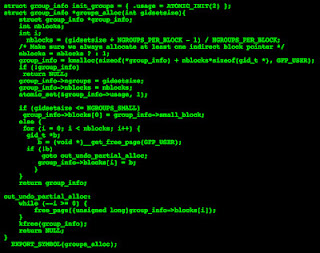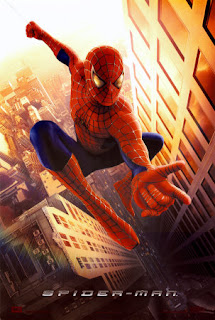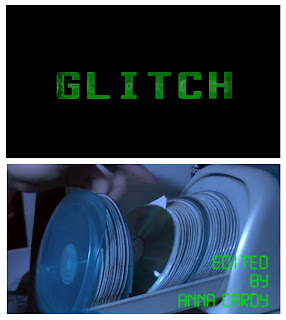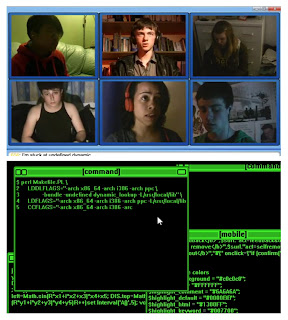Our product uses and develops many forms and conventions of real media products that we have researched, while challenging others to ensure that our product is unique and exciting.
Genre:
Our film, ‘Glitch’, is an action-thriller film. It closely follows the conventions of a typical opening sequence of this genre. For example, most commonly, the protagonist of an action-thriller would be a young adult male. We decided to stick with this convention as it is familiar to the audience and allows us to subvert expectations in other areas, such as the fairly equal gender divide amongst the hackers. Although our main character fits the typical ‘teen computer nerd’, we decided to show through our other characters that a hacker could, in fact, be anybody.
Our opening sequence displays typical events of our genre. For example, the sudden attack of the boss hacker and the suspenseful knock on the door at the end. These actions are made very clear to the audience to give them a solid sense of genre.
The film contains many conventional themes of the action-thriller genre:
- Good vs. evil
- Friendship
- Technology
- Suspense
 The theme of hacking in ‘Glitch’ gives it a sci-fi sub-genre. Hacking is a very visually recognisable and familiar theme in the movies, due to films like ‘The Matrix’, which was one of our main sources of inspiration. When considering how we would portray this hacking to the audience, we agreed that we should stick to the iconographic and conventional green text on black background, though we subverted these expectations by including group webcam windows, giving the characters a form of communication that the audience recognises. This was to allow character interaction; hacking is typically a solitary process. Interaction between characters adds the possibility of drama and conflict.
The theme of hacking in ‘Glitch’ gives it a sci-fi sub-genre. Hacking is a very visually recognisable and familiar theme in the movies, due to films like ‘The Matrix’, which was one of our main sources of inspiration. When considering how we would portray this hacking to the audience, we agreed that we should stick to the iconographic and conventional green text on black background, though we subverted these expectations by including group webcam windows, giving the characters a form of communication that the audience recognises. This was to allow character interaction; hacking is typically a solitary process. Interaction between characters adds the possibility of drama and conflict.In terms of iconography, the blue-lit set gives the sequence a sci-fi feel, while the teenage boy’s bedroom is more typical of the thriller genre.
Narrative Structure:
Conventions of an action/drama film:
- Todorov's three part structure: equilibrium, disruption, resolution
- Barthe's enigma code
- Levi-Strauss' binary opposites
How we included these theories in our film/opening:
Our opening sequence begins with the equilibrium of our group of hackers doing their job; something fairly familiar to them. The disruption arrives when their boss gets taken out. A further disruption occurs when our protagonist gets a knock on the door. Due to it only being the very beginning of the narrative, there is no resolution yet.
Our film follows the classic narrative pattern of Todorov’s three part structure, with a clear equilibrium, disruption and resolution. Although our sequence contains many examples of the enigma code, the most prominent ones are:
Who was it that took out the boss hacker? Is he still alive? Who is it knocking at the door?
Binary opposites we used include:
male v female, good v evil, experienced v unconfident, computer hacking v real-life action, music v quiet.
 |
| Peter Parker as Spiderman - another unlikely hero |
One of our main broken stereotypes is, as Vladimir Propp would call it, the ‘Princess’ role. Typically a young woman, the victim in our film is the boss hacker; the character represented as the most confident and commanding of the group. This then leaves our protagonist, the ‘rookie hacker’, to become our unlikely hero. This unexpected character role was inspired partly by Peter Parker's tranformation into Spider-Man.
Form:
A few typical features of an opening sequence:
- Titles
- A soundtrack
- A clear setting
The first two I have listed to show a couple of ways in which we have stuck to the typical features, as they are elements that make an opening sequence what they are. The third, however, we have only done to a degree. Of course, the protagonist’s bedroom is very clearly explored through the variety in shots, but we have not revealed any location outside this little ‘hacking bubble’. This is to give the film, or at least the opening to it, a global appeal, by promoting the idea that hacking can occur almost anywhere. By giving the opening a more general appeal, it is more likely that more people will continue to watch the film.
Functions of an opening sequence:
- To introduce characters
- To establish genre and themes
- To engage the audience
- To inlcude institutional information, e.g. distributor, director, producer
 |
| Our titles |
As explained before, the genre and themes are clearly established, and it is through these and the enigma code that we hope to engage the audience. The synergetic titles running throughout the sequence are very important, as they include all the essential institutional information needed in any opening sequence. An example of some research on titles I've done is the titles used in Edward Scissorhands (1990, Burton). I was particularly interested in the font used, as I felt it worked well to strongly establish the genre. This made me realise that our choice of font for our title would be essential, and I think the font we chose works very well.
Style:
Soundtrack: fast paced, typical action (helps to establish genre), works well with voiceover, matches fast-paced editing style.
Dialogue: weaves in with music, boss hacker is the only character to speak (1. To avoid confusion, 2. To solidify his leadership role and the way he dominates the operation) This was inspired by the narration of the hacking sequence in The Social Network (2010, Fincher)
 |
| Graphics used in sequence |
Pace: created through editing and music, action, builds up suspense. Begins slow, speeds up, and then slows to build tension at end.
Colour: dominantly blue, though still naturalistic. This creates a sci-fi mood but still maintains a realistic look.
Shot types: a lot of our shot choices were inspired by the opening to the film Masterminds (1997, Christian), for example, the shot at 0:34 of the typing.

No comments:
Post a Comment